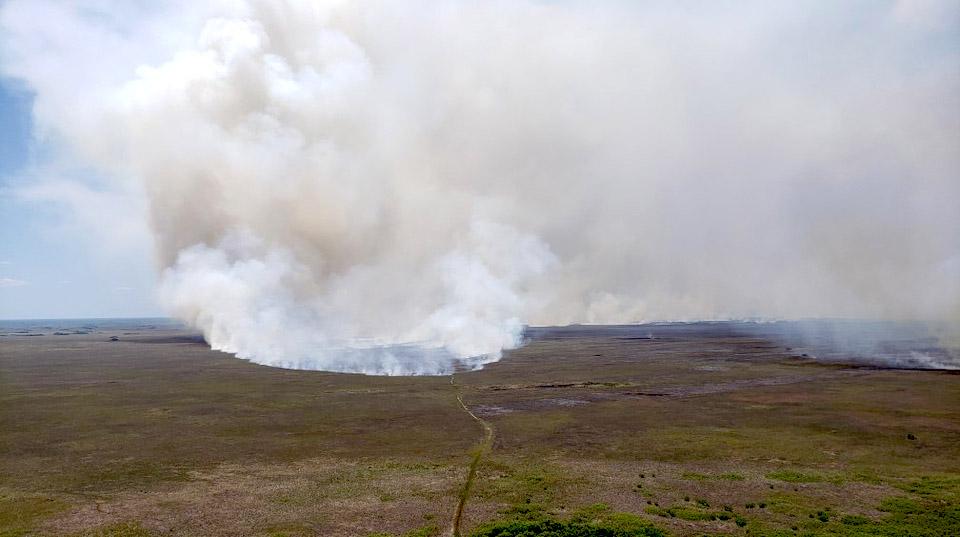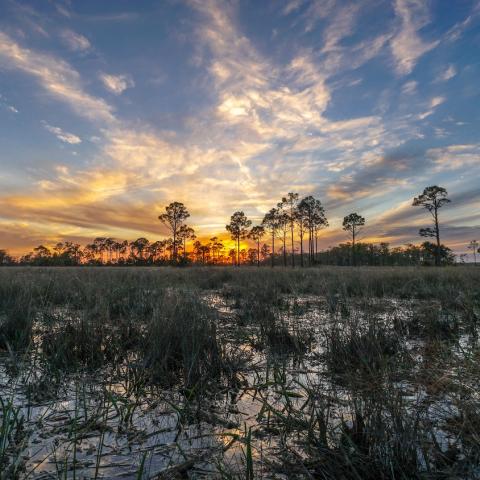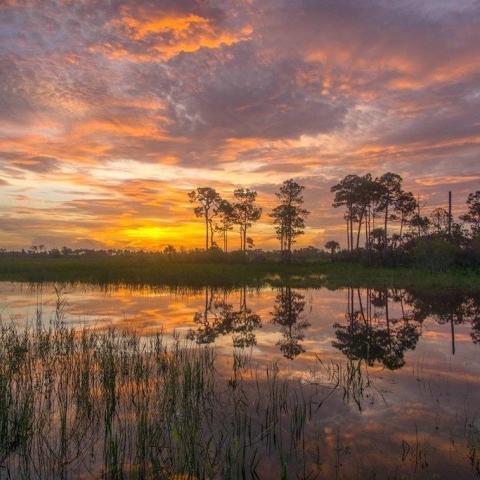
The Moon Fish Fire in Big Cypress National Preserve was nearing 30,000 acres Sunday/NPS
A fire in Big Cypress National Preserve in Florida was approaching 30,000 acres in size Sunday, burning across a large portion of the preserve's southeastern corner, threatening private structures in the area, and edging into Everglades National Park.
The blaze, ignited by a truck fire on May 7, was uncontained and being fed by unseasonably dry vegetation in the preserve. The fire was being fought from the sky with four helicopters and one air tanker, as well as ground crews supported by nine fire engines.
Nicknamed the Moon Fish fire, the blazed covered 27,037 acres Saturday evening. The Loop Road in Big Cypress was closed to tourists on both ends, with only local residents allowed to use it, and there was potential that smoke could close U.S. 41, the Tamiami Trail, at times. Winds could blow both the smell of the fire and smoke into the greater Miami area, a preserve release said.
Threatened by the flames were private residences in that portion of the preserve, the Tamiami Trail, and natural and cultural resources.

The Moon Fish Fire, outlined in red, was edging into Everglades National Park on Saturday/NPS
Local residents are encouraged to be aware of the “READY-SET-GO” strategy during the fire season.
- Ready! – Firewise your home, remove debris and reduce fuel loads around homes up to 100 feet.
- Set! – Prepare your family and home for the possibility of having to evacuate. Don’t forget your pets.
- Go! – Take the evacuation steps necessary to give your family and home the best chance of surviving a wildfire.
While fire season in the West usually doesn't begin until mid-summer, in Florida the spring usually is fire season.




 Support Essential Coverage of Essential Places
Support Essential Coverage of Essential Places







Comments
I know the vast majority of readers aren't focused on these kinds of issues right now; but, the answers to a few questions could help put this event into context ...just for the record. At "approaching" 30,000 acres, this fire is not small; but, given the overall size of the preserve, it seems confined to a corner of the whole. The article also notes this blaze "being fed by unseasonably dry vegetation in the preserve." How large is this fire in the historic context of the preserve and of that corner of it; is there a historic pattern of fires this size in that area of the preserve or is there any change in the frequency of fires of this size, especially in that area; and are the "unseasonably dry" conditions within historically normal patterns or is this, in any way, an unusual precipitation pattern?
The article indicates that this blaze was "ignited by a truck fire" and now "being fought from the sky with four helicopters and one air tanker, as well as ground crews supported by nine fire engines." What kind of truck and what kind of fire was it; where was the truck at the time; and what was it doing? Was it offroad? Was it, in any way associated, by ownership or activity, with recent or potential future oil exploration activities and were any of those activities taking place in the vicinity of the fire? Where within the preserve have those activities been concentrated so far?
It seems to be a pretty healthy firefighting effort. Where are those efforts concentrated and what is in that area? Any "civilian" damage or injuries so far?
Rump, you ask some great questions. Answers are few, however.
"All I have is what has been shared in our press release" was the response to questions regarding the name of the individual connected with the truck fire and any details surrounding the fire. Now, they did say the individual who owned the truck was cited, but wouldn't say for what or for how much. I decided not to mention the citation without that information.
Years ago when I covered the 1988 fires in Yellowstone, the NPS had daily briefings to update the media with the fires and firefighting efforts. While they might have such briefings at Big Cypress, we don't have staff in Florida, or the funding to hire a freelancer to spend days in the preserve covering the fire.
As you likely know, (and many might not) Traveler has only one full-time editor/reporter/bottle washer. Working seven days a week, well, it's wearing. Sometimes you just have to pick the stories you're going to invest several hours or more on.
And it's a balancing act. Do readers want that sort of detailed information? Right now the main interest seems to be in which parks are open and which are closed.
There definitely is interest in Traveler's coverage of national parks and protected areas. And there's certainly enough news out there to keep a full-time staff of five or six busy year-round. But here's the rub: While we had more than 3 million readers last year, the financial support for the Traveler is extremely thin.
Last week we ran a fund-raiser for three days. During those days, we had more than 41,000 readers. We received 42 donations to support our efforts. If those 3+ million each gave 50 cents once a year, we'd be set.
With your knowledge of the parks and the Park Service, Rump, you might be a very great fit on our board of directors, and I'm guessing would have some great (successful) ideas for raising funds for our mission. Drop me a line if you're interested.
From what I know and a quick skim of a few South Florida news sources and the Big Cypress Facebook page: https://www.facebook.com/BigCypressNPS/
This one started May 7 just south of the loop road; the individual was cited. I can't tell if the individual was cited for equipment failure or something specific to the ignition, or for being in that area. The usual seasonal closure to off road vehicles due to fire risk went into effect April 27 and runs until June 24.
This is one of several fires in Big Cypress this dry season. Yes, fires in Everglades and Big Cypress are normal, and needed, although they would tend to be naturally ignited at the end of the dry season with the first few thunderstorms with lightning but little or no rain. The natural fires would have been very large but moderate intensity, unlikely to kill most cypress trees. Because it is drier than usual this year, this fire might be too hot for the native plants to survive and resprout after, or it might be too close to Miccosukee houses along Tamiami Trail. I don't think this is an area with lots of dwarf cypress, but rather rocky glades, and current habitat for the endangered cape sable seaside sparrow, who would be nesting about now. That might be another reason why they are not letting it just burn.
Over the last few decades, FS sends many firefighters from the mountain west down to Florida & Georgia for the winter fire season. I have no idea whether the usual substantial number of crews are down there. I'm happy that they're primarily using aerial water, with trucks presumably along the eastern end of the loop road.
This is a fair distance east of where the seismic oil exploration happened, so I would doubt a connection, but I could be wrong.